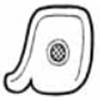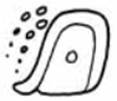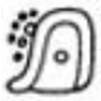| CMGG entry for syllabogram ye
|
|
Variant: hand
MC K&H JM TOK.p19.r2.c1
|
|
Variant: tooth
MC JM
MC JM K&H TOK.p16.r5.c4
· The main sign is a tooth in its iconographic origin. · The circle in the tooth is the inlaid jade bead, which was done in the front teeth of Classic Maya nobility.
Sub-variants (2) · A. No “dot cascade left”. · B. With “dot cascade left”: o Tokovinine (get reference) says that historically iconographic origin of the “dot cascade left” is droplets of saliva and that the dot in the centre is an inlayed precious stone (both associated with teeth). o There can be either one cascade or two. o Do not confuse this with the “tooth and bone” variant of ha, which has an oval element in the top left (with (optionally) three non-touching dots in a row inside), instead of the dot cascade.
|
|
Variant: head
25EMC.pdfp27 BMM9.p7 TOK.p25.r5.c2 PAL Tablet of the 96 Glyphs J5a
Stuart
Stuart
Stuart
· In all the examples except 25EMC, the eye is covered by a washer above and a trifoliate element below (leaves pointing downwards). · Do not confuse this with the visually (slightly) similar logogram K’EK’EN: o K’EK’EN has a mammal head while (the head variant of) ye has an anthropomorphic head. o The interesting point is that it seems in both cases of K’EK’EN and (the head variant of) ye, it is exactly the same unusual element covering the eye: a “washer with a trilobate element below it, leaves pointing downwards”.
|















